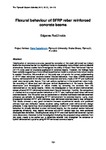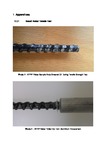Flexural behaviour of BFRP rebar reinforced concrete beams
| dc.contributor.author | Rudzinskis, E. | |
| dc.date.accessioned | 2019-05-20T16:02:10Z | |
| dc.date.available | 2019-05-20T16:02:10Z | |
| dc.date.issued | 2017 | |
| dc.identifier.citation |
Rudzinskis, E. (2017) ' | en_US |
| dc.identifier.issn | 1754-2383 | |
| dc.identifier.uri | http://hdl.handle.net/10026.1/14163 | |
| dc.description.abstract |
However, the findings have been variable suggesting a more refined experimental model to produce more robust results is needed. Therefore, the overall aim of this study was to improve the current understanding of BFRP rebar reinforced concrete beams’ flexural behaviour. Four class C28/35 concrete beams, reinforced with 8 mm diameter reinforcement elements, made of BFRP and traditional steel, were tested under flexure. The main actions carried out in the experiment were firstly, the recording of failure load and mid-span vertical displacements of the beams. Secondly, observation and investigation of failure modes by removing the concrete from the reinforcement of the tested beams. Thirdly, the investigation of how different reinforcement setups affected BFRP reinforced concrete beam flexural behaviour. Fourthly, the comparison of cracked and un-cracked section behaviour of BFRP and traditional steel rebar reinforced concrete beams. The fifth action was an assessment of whether traditional steel reinforcement principles are suitable for designing BFRP reinforcement for concrete beams. Lastly, crack propagation between BFRP and traditional steel reinforced concrete beams was compared. The results showed a very good correlation between experimental results and predicted ultimate load and deflection values obtained using traditional steel reinforcement design principles. It was found that the un-cracked sections of the BFRP reinforced concrete beam behaviour is virtually identical to steel reinforced beams, but the cracked section behaved completely differently. Also, beams reinforced with BFRP tension bars that were anchored displayed less deflection. Detailing issues using BFRP and steel hybrid reinforcement system were discovered, therefore further investigation including the proposed setup solutions from this study, needs to be carried out to determine whether they strengthen the evidence for hybrid reinforcement systems using BFRP reinforced concrete beams. | en_US |
| dc.language.iso | en | en_US |
| dc.publisher | University of Plymouth | |
| dc.rights | Attribution 3.0 United States | * |
| dc.rights.uri | http://creativecommons.org/licenses/by/3.0/us/ | * |
| dc.subject | flexural behaviour | en_US |
| dc.subject | rebar reinforced concrete beams | en_US |
| dc.subject | cracked and un-cracked section behaviour | en_US |
| dc.subject | BFRP | en_US |
| dc.subject | reinforced concrete beams | en_US |
| dc.title | Flexural behaviour of BFRP rebar reinforced concrete beams | en_US |
| dc.type | Article | |
| plymouth.issue | 2 | |
| plymouth.volume | 10 | |
| plymouth.journal | The Plymouth Student Scientist |




